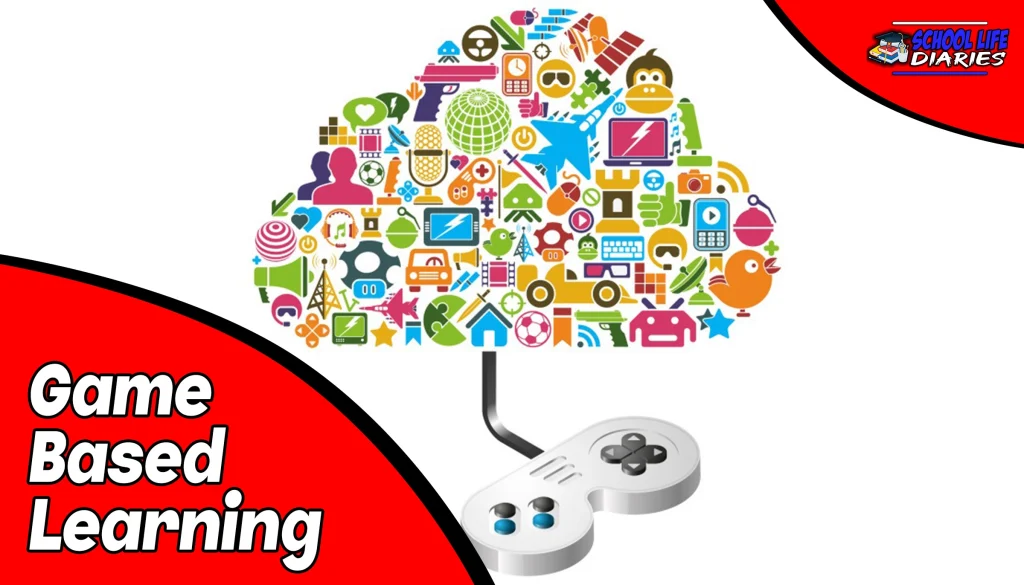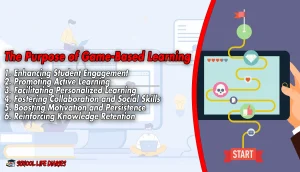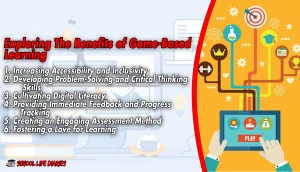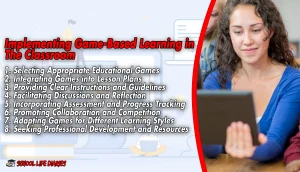Game-based learning has gained significant attention in recent years as an innovative educational approach. By combining elements of gameplay with educational content, this method aims to enhance student engagement, motivation, and learning outcomes.
In this blog post, we will explore the purpose of game-based learning and its potential benefits for students. So, let’s dive into the world of educational games and uncover their purpose!
The Purpose of Game-Based Learning
1. Enhancing Student Engagement:
Games have an inherent ability to captivate and engage players, and this principle holds true in educational settings as well. By incorporating game mechanics, such as challenges, rewards, and competition, into the learning process, students become active participants in their education.
The interactive nature of games motivates students to explore, experiment, and problem-solve, leading to increased engagement and attentiveness in the classroom.
2. Promoting Active Learning:
Game-based learning encourages active participation rather than passive consumption of information. Instead of passively listening to lectures or reading textbooks, students actively interact with the game environment, making decisions, and experiencing the consequences of their choices.
This active learning approach fosters critical thinking, decision-making skills, and the ability to apply knowledge in practical situations.
3. Facilitating Personalized Learning:
One of the significant advantages of game-based learning is its ability to adapt to individual learners’ needs and preferences. Games can offer personalized learning experiences by adjusting the difficulty level, pacing, and content based on the player’s abilities and progress.
This personalized approach helps students learn at their own pace, ensuring that they are neither overwhelmed nor bored. It also allows educators to identify students’ strengths and weaknesses more effectively and tailor instruction accordingly.
4. Fostering Collaboration and Social Skills:
Many educational games incorporate multiplayer features or collaborative elements, enabling students to work together towards common goals. By collaborating with peers, students learn important social skills such as communication, teamwork, and problem-solving in a cooperative setting.
This aspect of game-based learning prepares students for real-world scenarios where collaboration and effective communication are vital.
5. Boosting Motivation and Persistence:
Traditional learning methods can sometimes lead to a lack of motivation and disengagement among students. Game-based learning addresses this issue by providing a dynamic and interactive learning environment that is inherently engaging.
Through game mechanics like challenges, rewards, and progress tracking, students are motivated to overcome obstacles, persist in the face of failure, and achieve success. This boost in motivation and persistence contributes to improved learning outcomes and a positive attitude toward education.
6. Reinforcing Knowledge Retention:
Games have the power to reinforce learning and enhance knowledge retention through repetition and practice. By integrating educational content into gameplay, students have the opportunity to apply and reinforce their understanding of concepts repeatedly. This repetitive nature of games helps solidify learning and improves long-term retention of information.
Exploring The Benefits of Game-Based Learning
1. Increasing Accessibility and Inclusivity:
Game-based learning has the potential to cater to diverse learning styles and abilities. It provides interactive and multi-sensory experiences that can accommodate different learners, including those with special needs or learning disabilities. The visual and auditory elements, along with hands-on interactions, make learning more accessible and engaging for all students.
2. Developing Problem-Solving and Critical Thinking Skills:
Games often present players with challenges and puzzles that require problem-solving and critical-thinking skills to overcome. By immersing students in a game-based learning environment, they are encouraged to think critically, analyze situations, strategize, and find creative solutions to complex problems. These skills are invaluable in real-life situations, where the ability to think critically and solve problems is essential.
3. Cultivating Digital Literacy:
In today’s digital age, proficiency in technology is crucial. Game-based learning introduces students to various digital tools and platforms, helping them develop essential digital literacy skills. Students learn to navigate virtual environments, use interactive interfaces, and understand the principles of digital citizenship, including responsible online behavior and data privacy.
4. Providing Immediate Feedback and Progress Tracking:
Games offer immediate feedback to players, allowing students to understand their strengths and weaknesses in real time. This instant feedback helps students track their progress, identify areas for improvement, and make adjustments accordingly.
By providing feedback at the point of learning, game-based learning promotes a growth mindset and encourages continuous self-assessment and improvement.
5. Creating an Engaging Assessment Method:
Traditional forms of assessment, such as exams or quizzes, can sometimes be stressful for students. Game-based learning provides an alternative assessment method that is both engaging and informative. Assessments can be embedded within games, allowing students to demonstrate their knowledge and skills in a more relaxed and enjoyable manner.
6. Fostering a Love for Learning:
When learning becomes enjoyable and engaging, students develop a positive attitude toward education. Game-based learning taps into the natural curiosity and playfulness of students, making learning an exciting adventure. By fostering a love for learning, game-based approaches have the potential to create lifelong learners who are motivated to explore new concepts and ideas.
Implementing Game-Based Learning In The Classroom
1. Selecting Appropriate Educational Games:
When implementing game-based learning, it is crucial to choose educational games that align with your curriculum objectives. Look for games that cover the content you want to teach and provide a suitable level of challenge for your students. Consider factors such as age-appropriateness, subject relevance, and educational value when selecting games for your classroom.
2. Integrating Games into Lesson Plans:
Integrating games into your lesson plans requires thoughtful planning. Identify specific learning objectives that can be addressed through game-based learning and determine how games can be used to reinforce or introduce concepts. Create a roadmap for integrating games into your curriculum, ensuring a balance between traditional teaching methods and game-based activities.
3. Providing Clear Instructions and Guidelines:
When introducing games to your students, provide clear instructions and guidelines to ensure they understand the purpose and expectations. Explain how the game relates to the learning objectives and highlight the skills they can develop through gameplay. Set clear guidelines for behavior, collaboration, and responsible technology use during game-based activities.
4. Facilitating Discussions and Reflection:
After students engage in game-based learning activities, facilitate discussions and reflection sessions to deepen their understanding. Encourage students to share their experiences, strategies, and insights gained from playing the games. Ask open-ended questions to stimulate critical thinking and connect the gameplay to real-life situations or broader concepts.
5. Incorporating Assessment and Progress Tracking:
Assessment plays a vital role in game-based learning to monitor student progress and evaluate learning outcomes. Consider incorporating in-game assessments, quizzes, or follow-up assignments to assess students’ understanding and mastery of the content. Use progress-tracking features within educational games to monitor individual student performance and provide targeted feedback.
6. Promoting Collaboration and Competition:
Game-based learning provides opportunities for both collaboration and healthy competition among students. Encourage collaboration by assigning group tasks within games or promoting discussions and teamwork. Introduce elements of friendly competition to foster motivation and engagement. Recognize and celebrate students’ achievements to further motivate their learning journey.
7. Adapting Games for Different Learning Styles:
Recognize that students have diverse learning styles and game-based learning can be adapted to accommodate these differences. Provide options for auditory, visual, and kinesthetic learners within the game-based activities. Incorporate supplementary materials or alternative assignments to cater to individual learning preferences and ensure inclusivity.
8. Seeking Professional Development and Resources:
To effectively implement game-based learning, educators should seek professional development opportunities and access relevant resources. Attend workshops, conferences, or online courses that focus on game-based learning strategies.
Explore educational websites, online communities, and forums dedicated to game-based learning to discover new ideas, share experiences, and access valuable resources.
FAQs:
1. Can game-based learning be effective for all subjects?
Yes, game-based can be effective across various subjects, including mathematics, science, language arts, history, and more. Games can be designed to align with specific learning objectives and cover a wide range of topics.
2. Are there age limitations for game-based learning?
No, game-based can be adapted to different age groups and grade levels. There are games available for early childhood education, elementary school, middle school, high school, and even higher education.
3. How can educators integrate game-based learning into their curriculum?
Educators can incorporate game-based by selecting educational games that align with their curriculum objectives. They can integrate games as supplementary materials, create game-based activities, or even design their own games.
4. What are some examples of successful game-based learning initiatives?
One example is “Minecraft: Education Edition,” which allows students to explore and build in a virtual world while developing skills in various subjects. Another example is “Kahoot!,” a platform that offers interactive quizzes and games to engage students in learning.
5. Can game-based learning be used in remote or online education?
Absolutely! Game-based can be effectively used in remote or online education. Many educational games are available in digital formats, making them accessible for virtual learning environments.
6. How can game-based learning be assessed?
Assessment in game-based can take various forms, such as in-game performance tracking, quizzes or tests related to the game’s content, and observations of students’ problem-solving skills during gameplay.
Conclusion:
Game-based offers a purposeful and engaging approach to education. By leveraging the power of games, educators can enhance student engagement, promote active learning, personalize instruction, foster collaboration, boost motivation, and reinforce knowledge retention. The purpose of game-based learning goes beyond entertainment. It is a valuable tool for creating immersive and effective learning experiences.







